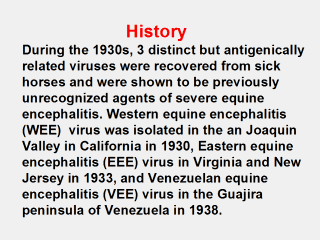 |
By 1938, EEE
and WEE viruses were seen as natural causes of encephalitis in humans, and
naturally acquired human infections with VEE virus were documented in
Colombia in 1952. EEE is the most severe of the arboviral encephalitides,
with case fatality rates of 50-70% and with neurologic damage common in
survivors. WEE virus appears to be less neuroinvasive but has a pathology
similar to that of EEE in patients with encephalitis. In contrast, severe
encephalitis is rare in humans infected with VEE virus—except in children.
In adults, the usual VEE syndrome is an acute, febrile, incapacitating
disease with prolonged convalescence.
A live attenuated VEE vaccine can be used for horses, and a formalin-killed
vaccine has been developed for use in humans. Formol-killed vaccine TC83VEE
has been used for many years. Many areas like vector control, including
chick or hamster sentinels are neglected, and thus epidemiologic actions are
too slow. Virus antigens are needed for the operation of a warning system.
What did some sentinel die of? |
